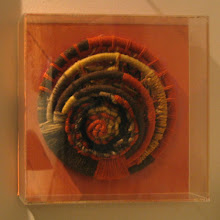Comments on a Maximo Laura's workshop:
I receive the Maison des Métiers D'art du Québec’s monthly newsletter (Quebec’s Centre of Artisans). In the September issue there was a notice about a free for artisans’ workshop by the Peruvian artist Maximo Laura in October and I immediately registered for it.
I knew his techniques are similar to the ones used by many Latin American tapestry artists but, as I saw his work only in the Internet I was intrigued by the way he applies them.The workshop took place in the “Gallerie Space Mexico” from the Mexican Consulate. Twenty of his works were exhibited there. Their bright colours were so attractive that many people stopped and came in to see them more closely. We were asked to bring a frame of any size and yarns that we want to work with. I was surprised to see half of the people didn’t have a clue on how to weave at all and some of them brought picture frames and heavily textured yarns. Others were experienced weavers who had never done a tapestry and brought table looms. I was the only tapestry weaver there. He accepted all that was put on the table and showed everything can eventually end being a good woven artwork.
The ‘atelier’ was mostly hands-on and everyone worked in their own level. I wouldn’t say that in my case I learned many new things but he showed me how to work differently in for ex. an unusual Soumak technique or the way of weaving a two-level circle. I’ll review some of my notes here:
He uses very fine Peruvian Alpaca # 3/32. Usually mixes his colours in butterflies of no more than six threads to attain regular textures working 45 to 55 warp threads each 10 cm. The warp thread is # 3/16. Weaving can be done with solid or blended colours. Blending gives rhythm and the chance to control any shape. Alternate blending produce contrast. Gradation produces the construction of textures. With the help of a small coloured design he organizes all the colour gradations before starting to weave. His weaving is done by going under two, over two because that gives the possibility to divide in levels and create textures. Borders have 4 threads to give them more strength. For wrappings, he uses cotton stuffing.Maximo is very gentle and smiles easily. He speaks English well and spoke Spanish to some of us who were Hispanophones. The fact that his work was exhibited in 40 countries makes him very proud. His hundreds of tapestries are part of many collections.
His table was covered by several cones of beautifully coloured yarns and many butterflies and at the end he said to us: “Take everything as I’m not taking them back to Peru!” I was shy and took only a couple of cones, the others took the rest and one of the ladies was courageous enough to take the small loom he used for demonstration and he answered with a big laugh! I’m adding some pictures I took.
The morning before the workshop’s first day I went to visit the “Centre des Textiles Contemporains de Montreal”. The centre occupies part of the 5th. Floor of a big office building situated far of the downtown core but, arriving by subway was easy.First room is the art gallery where the work of the local artist Anna Biro was exhibited.This exhibit marked the tone of what I would see in the rest of the centre. Called “Interactive Textiles” two transparent shiny weavings hanged from the ceiling. I was invited to touch them and they emitted provocative and sensual sounds. On a platform in a corner there was a sort of textured carpet. At this point I was greeted by a nice young guy who offered me a complete tour of the centre. He then said I can take off my shoes and walk on that carpet. I smiled and decided to touch it with my hands instead and it also started to emit sounds. He explained the weavings include recording tapes and filaments with sensors that react upon being touched. Very interesting show.Behind the gallery four big rooms make the classrooms. The first one is filled with tons of floor looms all computerized. I was explained how that works and I would say it’s probably a very time saving way of working but, doesn’t it take away the fun of it? The second room contained a huge jacquard loom. Very complicated piece of machinery. A student was sitting there arranging the warp threads. They explained me how it works. I concluded that I am a very old fashioned lady because I like to have control of my work all the time. Decidedly jacquard or computerized looms are not for me. The walls were covered by “tapestries” made with it and I saw them as fabric, no texture, no bright colours, nothing I can compare with what I saw later that afternoon and what I always experience in my own work. The third room was filled with all computerized knitting machines. Same feeling. The knitted results they have on their walls were very industrial for my taste. Fourth and last room was filled with sewing machines also computerized. Interesting way of making fashion creation easier.I didn’t expect to see all that when I planned my visit and I didn’t have my camera with me so, I have to apologize for not having pictures of it.
In August I


